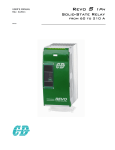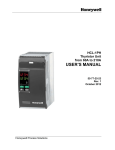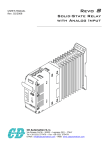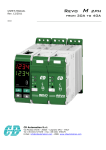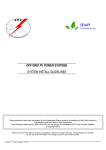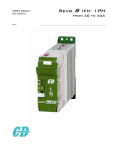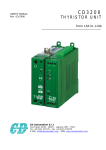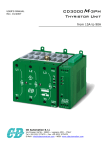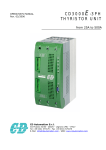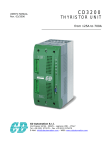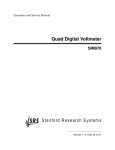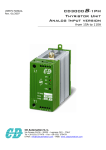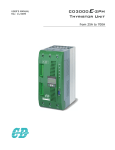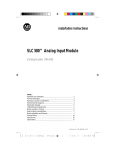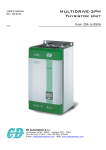Download Revo M - Isotron Systems
Transcript
Revo USER’S MANUAL Rev. 11/2009 M from 60A to 210A CD Automation S.r.l. Via Picasso 34/36 - 20025 – Legnano (MI) – ITALY Tel +39 0331 577479 – Fax +39 0331 579479 E-Mail: [email protected] - WEB: www.cdautomation.com CD Automation srl REVO M 2 User’s Manual CD Automation srl REVO M User’s Manual 1 Important warnings for safety ............................................................................................ 5 2 Note .................................................................................................................................... 6 3 Introduction ........................................................................................................................ 7 4 Advantages compared with analog thyristor unit ................................................................ 7 5 Software Configurator CDA Thyristor configurator software ............................................... 8 6 Quick Start .......................................................................................................................... 9 7 Basic Connections and sizing............................................................................................. 10 8 Identification and Order Code ........................................................................................... 11 8.1 Identification of the unit 11 8.2 Order Code 12 9 Internal Fuse..................................................................................................................... 13 9.1 Fuses Replacement 13 10 Installation...................................................................................................................... 14 10.1 Environmental installation conditions 14 10.2 Derating Curve 14 10.3 Dimensions and Weight 15 10.4 Fixing holes 15 10.5 Technical Specifications 16 11 Wiring instructions .......................................................................................................... 17 11.1 Power Terminals 17 11.2 Command Terminals 18 11.2.1 TERMINAL BLOCK M1................................................................................................................................18 11.2.2 TERMINAL BLOCK M2................................................................................................................................18 11.2.3 TERMINAL BLOCK M3................................................................................................................................18 11.3 Schematic 19 11.4 20 Connection Diagram for Single-phase 11.5 Connection Diagram for 3 phases (control on 2 phases) 21 11.6 Connection Diagram for 3 phases (control on 3 phases) 22 12 Control Panel................................................................................................................... 23 12.1 Scroll the parameters 24 13 Input output signal.......................................................................................................... 25 13.1 Digital Input 25 13.1.1 START/STOP (TERMINAL 3 OF M2) ...............................................................................................................25 13.1.2 CONFIGURABLE INPUT (TERMINAL 4 OF M2) ....................................................................................................25 13.2 Digital Output (terminal 5-6-7 of M1) 25 13.3 Analog Input 25 PRIMARY INPUT (TERMINALS 5 AND 6 OF M2)............................................................................................................25 14 Heater Break alarm and SCR short circuit (HB Option) .................................................... 26 14.1 Heater break Calibration procedure 26 14.2 HB alarm contact (digital output) 26 15 Firing type ....................................................................................................................... 27 15.1 Single Cycle SC (1Ph Only) 27 3 CD Automation srl REVO M User’s Manual 15.2 Burst Firing (BF) 28 15.3 Soft Start with Burst Firing S+BF (1Ph Only) 28 15.4 Phase Angle PA (1Ph Only) 29 15.5 Soft Start with Phase Angle (S+PA) 29 15.6 Delay Triggering DT (1Ph Only) 30 16 Feed-back type ................................................................................................................ 31 17 Analog Inputs.................................................................................................................. 32 PRIMARY INPUT (TERMINALS 5 AND 6 OF M1)............................................................................................................32 18 RS485 Serial Port ............................................................................................................ 32 19 PG Connector................................................................................................................... 33 20 MODBUS communication ................................................................................................. 34 20.1 MODBUS RTU Protocol 34 20.2 Message Format 34 20.3 Read Holding Registers 36 20.4 Preset Multiple Registers 36 20.5 Error and exception responses 37 20.6 Address Configuration 37 21 Configuration Parameters ............................................................................................... 38 22 Maintenance .................................................................................................................... 44 22.1 Trouble Shooting 44 22.2 Warranty condition 44 4 CD Automation srl REVO M User’s Manual 1 Important warnings for safety This chapter contains important information for the safety. The not observance of these instructions may result in serious personal injury or death and can cause serious damages to the Thyristor unit and to the components system included. The installation should be performed by qualified persons. The Thyristor unit are integral part of industrial equipments. When it is supply, the Thyristor unit is subject to dangerous tensions. • Don't remove the protection Cover. • Don't use these unit in aerospace applications and/ or nuclear. The nominal current corresponds to use at temperature not superior to 45°C. • The Thyristor unit must be mounted in vertical position and without obstruction above and below to allow a good flow ventilation. • The hot air of one thyristor unit must not invest the unit positioned above. • For side by side placed leave a space of 15mm between the unit. A suitable device must ensure that the unit can be electrically isolated from the supply, this allows the qualified people to work in safety. Protection (Protection, Protezione) The unit have IP20 protection rating as defined by the specific international. Is necessary consider the place of installation. Earth (Terre, Messa a terra) For safety, the Thyristor unit with isolated heat-sink must be connected to earth. Earth impedance should be correspondent to local earth regulation. Periodically the earth efficiency should be inspected. Electronic supply (Alimentation électronique, Alimentazione elettronica) The electronic circuit of the Thyristor unit must be supplied by dedicated voltage for all electronic circuits and not in parallel with coil contactors, solenoids and other. It's recommended to use a shielded transformer. Electric Shock Hazard (Risque de choque électrique, Rischi di scosse elettriche) When the Thyristor unit is energized, after the power supply is shut off, wait least a minute for allow the discharge of the internal capacitors where there is a dangerous tension. Before working, make sure that: • Only authorized personnel must perform maintenance, inspection, and replacement operations. • The authorized personnel must read this manual before to have access to the unit. • Unqualified People don't perform jobs on the same unit or in the immediate vicinities. REVO_M06 210_03 5 CD Automation srl REVO M User’s Manual Important warnings (Attention, Avvertenze importanti) During the operations with units under tension, local regulations regarding electrical installation should be rigidly observed: • Respect the internal safety rules. • Don't bend components to maintain insulation distances. • Protect the units from high temperature humidity and vibrations. • Don't touch components to prevent electrostatic discharges on them. • Verify that the size is in line with real needs. • To measure voltage current etc. on unit, remove rings and other jewels from fingers and hands. • Authorized personnel that work on thyristor unit under power supply voltage must be on insulated board This listing does not represent a complete enumeration of all necessary safety cautions. Electromagnetic compatibility (Compatibilità électromagnétique, Compatibilità elettromagnetica) Our thyristor units have an excellent immunity to electromagnetic interferences if all suggestions contained in this manual are respected. In respect to a good Engineering practice, all inductive loads like solenoids contactor coils should have a filter in parallel. Emissions (Emission, Emissioni) All solid-state power controllers emit a certain amount of radio-frequency energy because of the fast switching of the power devices. The CD Automation’s Thyristor unit are in accord with the EMC norms, CE mark. In most installations, near by electronic systems will experience no difficulty with interference. If very sensitive electronic measuring equipment or low-frequency radio receivers are to be used near the unit, some special precautions may be required. These may include the installation of a line supply filter and the use of screened (shielded) output cable to the load. 2 Note Warning: This icon is present in all the operational procedures where the Improper operation may result in serious personal injury or death Caution: This icon is present in all the operational procedures where the Improper operation can cause damage for the Thyristor unit. CD Automation reserves the right to modify the own products and this manual without any advise. REVO_M06 210_03 6 CD Automation srl REVO M User’s Manual 3 Introduction A thyristor unit is semiconductor device which acts as a switch formed by two thyristors in ant parallel. To switch on the alternating current the input signal will be on and the thyristor will switch off at first Zero Crossing voltage with no input signal. The benefits of thyristor units compared with elettromechanical contactors are numerouses: no moving parts, no maintenance and capacity to switch very fast. Thyristors are the only solution to control transformers and special loads that change resistance with temperature and with age. Thyristor Load 4 Advantages compared with analog thyristor unit Communication RS485 is a standard feature of REVO M this allows the use of many information like: current, power, load state and all the parameters for diagnostic and configuration. Ulterior advantages of the digital system vs the analogical is the flexibility and the possibility of implement special characteristics without change the hardware. Several strategies can be implemented and selected through the configuration parameters. With CDA software configuration, you can have access to the configuration parameters. To connect the Thyristor unit to the computer use the USB\TTL converter. REVO_M06 210_03 7 CD Automation srl REVO M User’s Manual 5 Software Configurator CDA Thyristor configurator software CDA Thyristor configurator software is free and is possible download it from our site: www.cdautomation.com If the Order Code is in line with requirement, then REVO M has been already configured in Factory and it's ready to use. You need the software only to modify the ordered configuration. Anyway we suggest to check the unit on the machine with the "Test unit" section. For install the software, launch the program and follow the instructions on the screen. Run the software configurator and set the serial port of the PC with con baudrate =19200(default) and the address of Thyristor unit (default=1). To connect the unit at the PC, it's necessary use the USB\TTL converter connected between the unit and the USB port of the PC. USB\TTL converter need a driver to work properly, you can find it at www.cdautomation.com Is available a full programmer kit composed by • • • • USB\TTL converter, Two cable CDA Thyristor configurator software USB driver With the CD-RS serial converter is possible configure the Thyristor unit also through the RS485 For this solution, the programming cable is not necessary. REVO_M06 210_03 8 CD Automation srl REVO M User’s Manual 6 Quick Start Attention: this procedure must be carried out by skilled people only. If your REVO M code is in line with what you really need, then the main configuration is already done by CD Automation and you just need to do the following steps: 1. Verify REVO M’s current sizing. Be sure that: • the load current is equal or less than the nominal one of REVO M • the main voltage is equal or less than the nominal voltage of REVO M 2. Verify the Installation 3. Verify the Wiring: • all auxiliary connections must be done in line with wirings on this manual • verify that there isn’t a short circuit on the load 4. Supply the auxiliary voltage of the unit Set the parameters U_OP (Operative Voltage) and A_Lo (Nominal Current of the load) using the frontal keypad or CDA Thyristor configurator software. Function: Min/Max: Default: Note: Function: Min/Max: Default: Operative Voltage V R/W It’s necessary to specify the operative voltage 24 ÷ 1000V 230 With voltage up to 330V and over 600V, REVO M needs hardware modifications: specify this in phase of ordination. Load nominal current A R/W It’s necessary to specify the load current value at nominal voltage. This current and voltage value are necessary to be able to read the power in engineering units 1 ÷ 100.0 Ampere (for size up to 100A) Nominal REVO M current value if load current has not been specified. If your REVO M code is NOT in line with what you really need, use the enclosed configurator software tool to set-up the unit. Install the software on your PC, select REVO M and click on test unit changing what you need. REVO_M06 210_03 9 CD Automation srl REVO M User’s Manual 7 Basic Connections and sizing Single phase wiring with resistive load (with REVO M-1PH) I= I P V V = Nominal voltage of the load I = Nominal current of the load P = Nominal power of the load Single phase wiring with inductive load (with REVO M-1PH) I= V P V cos φ V = Nominal voltage phase to phase I = Nominal current to the load P = Nominal power to the load Star wiring with resistive load (control on two phases with REVO M-2PH) I P I= 1,73V V V = Nominal voltage of the load I = Nominal current of the load P = Nominal power of the load Delta wiring with resistive load (control on two phases with REVO M-2PH) I P I= 1,73V V V = Nominal voltage of the load I = Nominal current of the load P = Nominal power of the load Star wiring with resistive load (control on three phases with REVO M-3PH) I P I= 1,73V V V = Nominal voltage of the load I = Nominal current of the load P = Nominal power of the load Delta wiring with resistive load (control on three phases with REVO M-3PH) I P I= 1,73V V V = Nominal voltage of the load I = Nominal current of the load P = Nominal power of the load Open Delta wiring with resistive load (with 3 X REVO M-1PH) I P I= 3V V V = Nominal voltage of the load I = Nominal current of the load P = Nominal power of the load REVO_M06 210_03 10 CD Automation srl REVO M User’s Manual 8 Identification and Order Code 8.1 Identification of the unit Caution: Before to install, make sure that the Thyristor unit have not damages. If the product has a fault, please contact the dealer from which you purchased the product. The identification's label give all the information regarding the factory settings of the Thyristor unit, this label is on the unit, like represented in figure. Verify that the product is the same thing as ordered . REVO_M06 210_03 11 CD Automation srl REVO M User’s Manual 8.2 Order Code 1 CODE 2 3 4 5 6 R M _ _ _ _ - 7 8 9 - _ _ _ 10 11 12 13 14 15 16 _ _ _ _ _ _ _ PHASES CONTROLLED 1PH 2PH 3PH 1 2 3 Current Rathing 60A With Heat-sink 90A With Heat-sink 120A With Heat-sink 150A With Heat-sink 180A With Heat-sink 210A With Heat-sink 0 0 1 1 1 2 6 9 2 5 8 1 0 0 0 0 0 0 MAX VOLTAGE 480V 600V 4 6 Load Voltage and Aux.Voltage Supply Range 90:130V 170:265V 230:345V 300:530V 510:690V 1 2 3 5 6 INPUT 0-10V dc 4-20 mA 10k Pot SSR V A K S Firing ZC Zero Crossing BF Burst Firing SC Single Cycle (only 1PH unit) S+BF Soft Start + Burst Firing1 (only 1PH unit) PA Phase Angle (only 1PH unit) PA+S Phase Angle + Soft Start (only 1PH unit) DT Delayed Triggering1 (only 1PH unit) Z B C J P E D Control Mode None V Voltage (available with BF,SC,S+BF and DT) VxI Power (available with BF,SC,S+BF and DT) 0 U W Options IFH (≤45A) or IF(>45A) + CT IFH (≤45A) or IF(>45A) + CT + HB Y H 110V fan option None 110V fan option available ≥ 120A 0 1 Approval None cUL us (soon available) 0 L Manual None Italian English German French (soon available) 0 1 2 3 4 Version Version 1 standard Version 2 Special REVO_M06 210_03 1 2 12 CD Automation srl REVO M User’s Manual 9 Internal Fuse The thyristor unit have internal fuse extrarapid at low I²t for the thyristor protection of against the short-circuits. The Fuses must have I²t 20% less than thyristor's I²t. The warranty of thyristor is null if no proper fuses are used. Type Fuse Code Spare Part Current (ARMS) I²T (A² sec.) Vac 060 100FE 100 2800 660 090 FEE200 200 11400 660 120 FEE200 200 11400 660 150 FEE200 200 11400 660 180 URB315 315 82000 660 210 URB315 315 82000 660 Caution: High speed fuses are used only for the thyristor protection and can not be used to protect the installation. Caution: The warranty of thyristor is null if no proper fuses are used. See tab. Warning: When it is supply, the Thyristor unit is subject to dangerous voltage, don't open the Fuse-holder module and don’t touch the electric equipments. 9.1 Fuses Replacement Open the cover and remove the screws REVO_M06 210_03 Open the cover and remove the screws 13 CD Automation srl REVO M User’s Manual 10 Installation Before to install, make sure that the Thyristor unit have not damages. If the product has a fault, please contact the dealer from which you purchased the product. Verify that the product is the same thing as ordered. The Thyristor unit must be always mounted in vertical position to improve air cooling on heatsink. Maintain the minimum distances in vertical and in horizontal as represented. When more unit has mounted inside the cabinet maintain the air circulation like represented in figure. Sometimes is necessary installing a fan to have better air circulation. 10.1 Environmental installation conditions Ambient temperature 0-40°C at nominal current. Over 40°C use the derating curve. Storage temperature -25°C a 70°C Installation place Don’t install at direct sun light, where there are conductive dust, corrosive gas, vibration or water and also in salty environmental. Altitude Up to 1000 meter over sea level. For higher altitude reduce the nominal current of 2% for each 100m over 1000m Humidity From 5 to 95% without condense and ice 10.2 Derating Curve REVO_M06 210_03 14 CD Automation srl REVO M User’s Manual 10.3 Dimensions and Weight REVO M 1PH REVO M 2PH REVO M 3PH Size W(mm) H(mm) D(mm) Weight (kg) 1PH 93 170 274 3,4 2PH 187 170 274 6,8 3PH 281 170 274 10,2 10.4 Fixing holes REVO M 1PH REVO_M06 210_03 REVO M 2PH REVO M 3PH 15 CD Automation srl REVO M User’s Manual 10.5 Technical Specifications General features: Cover and Socket material: PolymericV2 Auxiliary voltage: 90:130V 170:265V 230:345V 300:530V 510:690V Relay output for Heater Break Alarm (only with HB option): 0.5A a 125VAC Input features: Logic input SSR: Analogic input 4 ÷ 30Vdc 5mA Max (ON ≥ 4Vdc OFF < 1Vdc) Analogic input 4 ÷ 20mA impedance 100 ohm POT 15 K ohm min. Digital Input 4 ÷ 24Vdc 5mA Max (ON ≥ 4Vdc OFF < 1Vdc) 0 ÷ 10Vdc impedance 15 K ohm Output features(power device): Current Voltage range Repetitive peak reverse voltage Latching current Max peak one cycle Leakage current I2T value max (A) (V) (480V) (600V) (mAeff) (10msec.) (A) (mAeff) tp=10mse c (Hz) I=Inom (W) Vac Frequency Isolation Power loss range Voltage 60 24÷600 1200 1600 450 100 15 4750 47÷70 216 2500 90 24÷600 1200 1600 450 2000 15 19100 47÷70 324 2500 120 24÷600 1200 1600 450 1540 15 11300 47÷70 270 2500 150 24÷600 1200 1600 450 2000 15 19100 47÷70 324 2500 180 24÷600 1200 1600 300 4800 15 108000 47÷70 810 2500 210 24÷600 1200 1600 300 5250 15 128000 47÷70 1080 2500 REVO_M06 210_03 16 CD Automation srl REVO M User’s Manual 11 Wiring instructions The Thyristor unit could be susceptible to interferences lost by near equipments or by the power supply, for this reason in accord to the fundamental practices rules is opportune take some precautions: • The coil contactor, the relays and other inductive loads must be equipped with opportune RC filter. • Use shielded bipolar cables for all the input and output signals. • The signal cables must not be near and parallel to the power cables. • Local regulations regarding electrical installation should be rigidly observed. Use copper cables and wires rated for use at 75°C only. Power cable torque (suggested) Type Connector Type Torque Lb-in (N-m) 060 090 120 Screw M6 70.8 (8.0) 150 180 210 Screw M8 265 (30.0) Cable dimensions 0.5mm² (AWG 18) Cable dimensions 16 mm² (AWG 6) up 25 mm² (AWG 4) up Wire Range mm²(AWG ) MAX Current Terminals Wire Terminals UL Listed (ZMVV) 1 150 Fork/Spade Terminal Copper Tube Crimp.Lug 1 3/0 250 Copper wire Compact (Solid) Stranded of the Command Terminals of the Earth (suggested) to 120A to 210A Warning: Before connecting or disconnecting the unit check that power and control cables are isolated from voltage sources. 11.1 Power Terminals Terminal Description L1 Line Input Phase 1 T1 Load Output Phase 1 L2 Line Input Phase 2 T2 Load Output Phase 2 (only for 3pH) L3 Line Input Phase 3 T3 Load Output Phase 3 REVO_M06 210_03 (only for 3pH) (only for 2Ph and 3Ph) (only for 2Ph and 3Ph) 17 CD Automation srl REVO M User’s Manual 11.2 Command Terminals Warning: Before connecting or disconnecting the unit check that power and control cables are isolated from voltage sources. 11.2.1 Terminal block M1 Terminal Description 1 GND 2 COM digital Input 3 Configurable Enable 4 Configurable Input1 5 Control Input + 6 Control Input - 7 +10V Output 8 Not connected 9 Common alarm relay output 10 Normally open\close alarm relay output 11 RS485 A 12 RS485 B 11.2.2 Terminal block M2 Terminal L1 L2/N Description Aux L1 Not Connected Aux L2/N 11.2.3 Terminal block M3 Terminal Description F1 Fan supply F2 Fan supply REVO_M06 210_03 18 CD Automation srl REVO M 11.3 Schematic REVO_M06 210_03 19 User’s Manual CD Automation srl REVO M User’s Manual 11.4 Connection Diagram for Single-phase TOP VIEW DOWN VIEW Ln 1 2 3 4 5 6 7 8 9 10 11 12 1 2 3 4 5 6 7 8 9 10 11 12 Tn M2 M3 M1 Caution: this procedure must be performed only by qualified persons. REVO_M06 210_03 20 CD Automation srl REVO M User’s Manual 11.5 Connection Diagram for 3 phases (control on 2 phases) Caution: this procedure must be performed only by qualified persons. Load Type T1 T2 T3 T1 Delta REVO_M06 210_03 T2 Star 21 T3 CD Automation srl REVO M User’s Manual 11.6 Connection Diagram for 3 phases (control on 3 phases) Caution: this procedure must be performed only by qualified persons. Load Type T1 T2 Delta REVO_M06 210_03 T3 T1 T2 T3 L1 L3 L2 Open Delta T1 T2 Star 22 T3 T1 T2 T3 Star + Neutral N CD Automation srl REVO M User’s Manual 12 Control Panel The Control Panel is placed on the front of the thyristor unit, on his display you can visualize the alarms, the input and output signals and all the configuration parameters . The function keys are the following: • • • • The The The The Function key F is used to scroll the parameter. UP key and DOWN key are used to set the parameters in the menu and to change data. L/R key is used to edit the parameters and to save the modified values. F+L/R is used for enter and exit from the menu. The Control Panel have three menu, and to enter in one of them you must set correctly the parameter : • Operator Menu ( = 2) This menù contains a reading parameters that give information on the state of the unit, it include also the base parameters for quick start, like the value of current and voltage load and the Set-point data. • Hardware Menu ( = 5) This menu contains all the configuration parameters for analogic and digital I/O, and the parameters to set the serial port like the address and the baudrate. • Setup Menu ( = 10) This menù contains all the setting parameters to configure the thyristor unit, like the firing type, the current limit, [ecc]. REVO_M06 210_03 23 CD Automation srl REVO M 12.1 Scroll the parameters REVO_M06 210_03 24 User’s Manual CD Automation srl REVO M User’s Manual 13 Input output signal 13.1 Digital Input The REVO M thyristor unit has 2 digital inputs opto-isolated to 24Vdc 5 mA. You can activate the inputs with the internal supply or with an external source for example the PLC. 13.1.1 Start/Stop (Terminal 3 of M1) This is the start command (Enable) of the REVO M. If you Remove the Start command the REVO M thyristor unit will be stopped and the output will return at zero. 13.1.2 Configurable Input (Terminal 4 of M1) This digital input is configured by the parameter • Enable: This function forces the output at zero. • Feed-Back Selection: With this function, when you active the input, the Voltage Feed-Back (V). • Analog/Digital Setpoint(Local/Remote: With this function, when you active the input, the Digital value, setted in the parameter . • Change Firing type: With this function, when you active the input, the Phase Angle PA (available only on 1PH). 13.2 Digital Output (terminal 9-10 of M1) and could perform different functions: feed-back setted in the parameter change in setpoint reference change from Analog input to Firing type setted in the parameter change in The REVO M thyristor unit has 1 relay output on terminal 9-10 of terminal block M1(Max 500mA, 125Vac). The functionality of this output cane be setted with the parameter This digital output can be configured in order to activate itself after that one of these alarms occours: • HB and SC alarm are active. • Only HB alarm is active. • Only SC alarm is active. 13.3 Analog Input Primary Input (Terminals 5 and 6 of M1) The REVO M thyristor unit has 1 analog inputs (0÷10V, 0÷20mA, 4÷20mA ecc): The primary input for the analog setpoint. The primary input is already configured in line with customer requirements that are defined in the Order Code. The Order Code is written on the identification label. However, if you wish to change the primary input (ex. from 0÷10V to 0÷20mA, 4÷20mA). REVO_M06 210_03 25 CD Automation srl REVO M User’s Manual 14 Heater Break alarm and SCR short circuit (HB Option) Caution: to work properly the load must be powered at least about 160msec. The Heater Break circuit read the load resistance with an Internal voltage transducer and Internal current transformer (C.T.), to calcolate the resistance (V/I). Minimum current is 10% of the current transformer size. If load current is below this value the Heater Break Alarm doesn’t work properly. 14.1 Heater break Calibration procedure An automatic function sets the Heater Break Alarm. Write in the parameter and If load current decreases for partial or total load failure (sensitivity 20%) HB alarm become ON and alarm relay change status. If the unit is still in conduction with no input signal (LED green OFF) it means that there is a short circuit on thyristors and (SC) become ON. You can Adjust the sensibility of HB alarm by using the parameter This parameter is setted between 1 and 255% of the nominal resistance. This parameter is the maximum reduction of the resistance Load to establish the HB Alarm. There is also parameter to set a delay to have HB alarm active. 14.2 HB alarm contact (digital output) The Revo unit with HB option, is supplied with Heater Break alarm contact normally opened (NO): • In normal conditions (without alarm) and with auxiliary power supply, the contact to the terminals has opened (relay coil energized). • In alarm condition or without auxiliary power supply the contact to the terminals is closed (relay coil not energized). This alarm can be configured in order to activate itself after that one of these alarms occours: • HB and SC alarm are active. • Only HB alarm is active. • Only SC alarm is active. • Disable the relay output. REVO_M06 210_03 26 CD Automation srl REVO M User’s Manual 15 Firing type Choose an correct firing type allows to optimize the thyristor unit for the installed load. The firing type has already configured in line with customer requirements that are defined in the Order Code. The Order Code is written on the identification label. However, if you wish to change the firing type you can use the software configurator or the Control Panel. Caution: this procedure must be performed only by qualified persons. 15.1 Single Cycle SC (1Ph Only) Single Cycle it's the faster zero crossing switching method in relationship of the power demand from a temperature regulator or from an external signal. With input signal at 25% the output is one cycle ON and three cycles OFF With input signal at 50% the output is one cycle ON and one cycle OFF With input signal at 75% the output is three cycles ON and one cycle OFF With input signal at 76% the output is the same of 75% but for each ON cycle the microprocessor divides 76/75, and when the sum of rests is one, the unit does one more cycle ON. For this firing is necessary to have analog input. The Single Cycle is used to control the loads with low inertia or for infrared lamps to short wave. ON OFF VOLTAGE SUPPLY (V) LOAD VOLTAGE (V) 25% 50% 75% 100% REVO_M06 210_03 27 CD Automation srl REVO M User’s Manual 15.2 Burst Firing (BF) The Burst Firing is similar to the Single Cycle, but consecutive cycles ON are selectable between 2 and 255, with input signal equal at 50%. Burst Firing is a method zero crossing that it reduces the electromagnetic interferences because the thyristor switches at zero voltage crossing. The example show the Burst Firing with Burst cycles: =4 ON OFF VOLTAGE SUPPLY (V) LOAD VOLTAGE (V) 25% 50% 75% 100% 15.3 Soft Start with Burst Firing S+BF (1Ph Only) This is an additional function to the Burst Firing. The unit start in phase angle mode with a ramp starting from zero up to the full tension in the cycles number set in the parameter . When the ramp is over, the thyristor unit will stay in conduction at full voltage up to the end of cycles of burst. The S+BF firing is used to control small inductive loads to avoid inrush surge current and to reduce the electromagnetic interferences. The example show the firing with Burst cycles: =4 and ramp cycles: =3 ON OFF VOLTAGE SUPPLY (V) LOAD VOLTAGE (V) 25% 50% 75% 100% REVO_M06 210_03 28 CD Automation srl REVO M User’s Manual 15.4 Phase Angle PA (1Ph Only) The Phase Angle firing allow the control of the power on the load, for this firing the thyristor can be in conduction only for a part of the voltage cycle. This part of the voltage cycle is adjustable in function of the input signal from 0 at 100%. The PA firing is normally used for control the inductive loads, and is also possible control a primary of transformer coupled with the cold resistances like: Superkanthal, Molybdenum, Platinum, Tungsten or Quartz Lamp. The only disadvantage with phase angle is the possible generation of interferences that however can be reduced with opportune filters. ON OFF VOLTAGE SUPPLY (V) LOAD VOLTAGE (V) 25% 50% 75% 100% 15.5 Soft Start with Phase Angle (S+PA) This is an additional function to the Phase Angle. The firing angle of the thyristor increase or decrease up to the final setpoint value. The Soft start ramp is an important feature to reduce the inrush current with transformers during the during the cycle of magnetization or with cold resistance that are near to the short circuit when they are supplied. Setpoint Ramp Up : Setpoint Ramp Down: ON OFF VOLTAGE SUPPLY (V) Setpoint Value (%) 100% 0% Load voltage RMS (V) Ramp Up Ramp Down OUTPUT VOLTAGE (V) REVO_M06 210_03 29 CD Automation srl REVO M User’s Manual 15.6 Delay Triggering DT (1Ph Only) The Delay Triggering firing is used the control a primary of transformer coupled with the normal resistances on the secondary (N.B. don't connect cold resistances on the secondary like: Superkanthal, Molybdenum, Platinum, Tungsten, Quartz Lamp). For an inductive load (ex transformer), switching the thyristors at zero crossing can generates transient over currents that can blow the fuses, to avoid this problem you must use the Delay Triggering. This firing delay the first half cycle of Burst for an angle from 0 to 100° relative to the zero, besides all the first burst start with soft start ramp to reduce the inrush current during the cycle of magnetization. Without Delay Triggering With Delay Triggering Transient over-current Delay angle (0° to 100°) Voltage Current Current Voltage 0 0 Zero Crossing Voltage Zero Crossing Voltage For understand the Delay Triggering firing, we have represented the waves generate by vectors that rotates in counterclockwise: Without Delay Triggering With Delay Triggering y y V2 I2 V2 I2 V1 i2 i2 V1 Delay Angle I1 x i1 i3 α x i3 I1 I3 I3 V3 V3 Without delay at zero crossing when V1 is to zero (projected on the X axis) the unit switch On. In this case the instantaneous value of the currents are i1, i2 and i3 and this condition, for the curve of magnetization, could generate transient over currents that can blow the fuses. With Delay Triggering the firing of the thyristor are triggered with a delay until the instantaneous value of the curret i1=0, i2 positive and i3 negative like represented. In this case the risk of transient over currents is reduced and the fuses don't blow. The angle alpha is the delay to have i1=0 and this angle depends on the power factor. The delay angle suggest for most applications is 80° REVO_M06 210_03 30 CD Automation srl REVO M User’s Manual 16 Feed-back type The Feed-back type has already configured in line with customer requirements that are defined in the Order Code. The Order Code is written on the identification label. However, if you wish to change the Feed-back type you can use the software configurator or the Control Panel. Caution: this procedure must be performed only by qualified persons. The Feed-back type is defined by the parameter . If the configurable digital input has set like Feed-Back Selection , it's possible to change the select FeedBack with the Voltage Feed-Back (V) simply activating the input. The feed-back defines the Control Mode. It’s possible to have: • V=Voltage feed-back. The input signal is proportional to the output voltage. This means that input signal becomes a voltage demand. This control mode compensates the voltage fluctuation of the incoming line supply. • I=Current feed-back. The input signal is proportional to the current output. This means that input signal becomes a current demand. This control mode maintain the current also if the load impedance changes. • W=Power feed-back. The input signal is proportional to the power output. This means that input signal becomes a power demand. The power remains constant also if voltage and load impedance change. This control mode is used with silicon carbide elements that change its resistive value with temperature and with age. In addition it compensates the voltage fluctuation of the incoming line supply. • V2=Square Voltage feed-back. The input signal is proportional to the output square voltage. This means that input signal becomes a power demand. The power remains constant if the load impedance doesn't change. • NO=No Feedback Open Loop. The input is proportional to the firing angle ( REVO_M06 210_03 31 α ). CD Automation srl REVO M User’s Manual 17 Analog Inputs The REVO M thyristor unit has 2 configurable analog inputs (0÷10V, 4÷20mA, ecc): The primary input for the analog setpoint, the secondary input for the Current Profiler or Ext. Feed-Back. Primary Input (Terminals 5 and 6 of M1) The primary input is already configured in line with customer requirements that are defined in the Order Code. The Order Code is written on the identification label. However, if you wish to change the primary input (ex. from 0÷10V to 4÷20mA) proceed as follows: Primary Input calibration procedure When you change the hardware setting is necessary make the Input calibration procedure. To make the Input calibration procedure follow these steps: • Give the power supply. • With Control Panel go in the Hardware menu ( = 5) • Set the input signal to the min value (ex. 0V for 0÷10V or 4mA for 4÷20mA) • Set the parameter = 1 • Press ENTER key • Set the input signal to the max value (ex.10V for 0÷10V or 20mA for 4÷20mA) • Set the parameter = 1 • Press ENTER key The Input calibration procedure is done. 18 RS485 Serial Port The serial communication port RS485 is available on the Command Terminals and on the 9pin DIN male connector. On this port may be done a network up to 127 REVO M. On the 9pin DIN male connector is also possible connect the CD-EASY Terminal M1 11 12 REVO_M06 210_03 Description RS485 A RS485 B 32 CD Automation srl REVO M User’s Manual 19 PG Connector The PG Connector is used to configure the thyristor unit with the configuration software and with the programming cable. The programming cable is not included. REVO_M06 210_03 33 CD Automation srl REVO M User’s Manual 20 MODBUS communication The serial communication port of the thyristor unit is two-wire RS485 type. This port use an half-duplex system. When a Unit must transmit active the transmission line, and when there are not units in transmission the outputs are fixed to high impedance. The serial communication port allows to communicate between the thyristor units and a MASTER device (ex. an computer or a terminal). The cable must be rated for use to data transfer 20.1 MODBUS RTU Protocol The communication is based on the standard industrial MODBUS RTU with the following restrictions: • • The Baud rate can be 4800-9600-19200 Baud (Standard 19200). The Preset Multiple Registers (Funct. 16) is limited to the writing of a single parameter for message. The following MODBUS functions are supported: Function 03 16 Description Read Holding Registers Preset Multiple Registers The unit support the Broadcast messages: It' possible send a Broadcast messages using the address 0, all the units respond at the message without sending back any reply. 20.2 Message Format The transmission format is a 1 bit start, 8 date bit, and 1 bit stop with no parity verification. Each message terminate after a said time of "time out", equal at 3.5 time of a character transmission, where there are not transitions on the transmission line. The first Byte of each message is always the address of the unit that is a value from 1 to 255 or 0 for the broadcast messages, the second is always the function number, and the rest of the message depends of the function demand. When a Slave receive an message, the unit send an answer with the same structure but with the information demanded. Each message is followed by CRC (Cyclic Redundancy Check) with two byte. The CRC identify the incongruity situations of the message, in this case the receiver ignore the message. The CRC is calculated in accordance with a formula that imply a recursive division of the data by a polynomial. The polynomial divisor is: 216 + 215 + 22 + 1(Hex 18005) but is modified in two ways: • Since the bits order are reversed, then the binary pattern is also reversed, and the most significant bit (MSB) is the right-most bit. • Since interest only the remainder, the right-most bit could be discarded. Therefore, the polynomial divisor has value: Hex A001 Normal bit order: Least significant bit Most significant bit Most significant Byte Least significant Byte Reversed bit order: Least significant bit Most significant bit Least significant Byte Most significant Byte N.B.: With the reversed bit order, also the CRC16 returns the with the reversed bit order REVO_M06 210_03 34 CD Automation srl REVO M The following flow-diagram show how to organize the CRC 16 bit. C Language CRC 16 Example static short CRC16 (unsigned char *p_first,unsigned char *p_last) { unsigned int crc=0xffff; short j; for (;p_first<=p_last;p_first++) { crc ^= *p_first; for(j=8;j>0;j--) { if(crc & 0x0001) { crc = crc >> 1; crc ^= 0xA001; } else { crc = crc >> 1; } } } return (crc); } REVO_M06 210_03 35 User’s Manual CD Automation srl REVO M User’s Manual 20.3 Read Holding Registers This function reads the instantaneous value of a specified number of parameters from an address. The message is composed by 8 Byte: one Byte is for the address, one for the function (03 Hex), two Byte for the first parameter to read, two Byte for the total number of parameters to read and finally two Byte for the CRC: Address Unit Function 3 3Hex Address of the First Parameter HI N° of the Parameter LO HI CRC 16 LO LO HI The answer is an echo of the first two Byte (address and function), one byte with the number of following byte to exclusion of the CRC, the demanded values and finally two Byte for the CRC: Address Unit Function N° of Byte 3 3Hex First Parameter Value HI Last parameter value LO … HI LO CRC 16 LO HI 20.4 Preset Multiple Registers This function could write only a parameter for each message. The message is composed by 11 Byte: one Byte for the address, one for the function (10 Hex), two Byte for first parameter to write, two Bytes for the N° of parameters, fixed to 1 (0001 Hex), one Byte with the number of following Bytes, fixed to 2 (02 Hex), two Byte for the CRC: Address Unit Function 16 10Hex Address of the First Parameter HI LO N° of the Parameter 0 N° of Byte 1 2 Value to write HI LO CRC 16 LO HI The answer is an echo of the first two Byte (address and function), two Byte for first written parameter, two Byte with the N° of parameters, fixed to 1 (0001 Hex), two Byte for the CRC: Address Unit Function 16 10Hex REVO_M06 210_03 Address of the First Parameter HI N° of the Parameter LO 0 36 1 CRC 16 LO HI CD Automation srl REVO M User’s Manual 20.5 Error and exception responses If a message contains an altered character, if fails the CRC, or if the received message contains a syntax error (for example the number of the byte or of the words is not correct), then the unit will ignore the message. If the received message is correct but contains a not valid value, the unit will send an answer of exception (5 byte): Address Unit Function Error Code CRC 16 LO HI The byte with the function number, represent the function number of the message that has caused the error with the first Bit set to 1 (ex. the function 3 becomes 0x83) The error code could be one of the followings: Error Code Name Cause 1 ILLEGAL FUNCTION Function not supported. 2 ILLEGAL DATA ADDRESS Address out of range. 3 ILLEGAL DATA VALUE Attempt to write invalid or action not carried out. NOTE: If you write a parameter's value equal at his actual value this is a valid transaction and don't cause an error. 20.6 Address Configuration The thyristor unit is assigned a unique device address by the user in the range 1 (default) to 127 using the parameter P115 in the Hardware menu. This address is used to recognise the messages queries to her assigned. The thyristor unit does not respond at the messages queries that don't have the same assigned address. The thyristor unit will also accept global messages (Broadcast) sends at the address 0. No responses are returned for globally addressed queries. REVO_M06 210_03 37 CD Automation srl REVO M User’s Manual 21 Configuration Parameters The Configuration Parameters are accessible from the Control Panel (place in front of unit), from the software configurator or through the serial communication port RS485. With the RS485 Serial Port the parameters are not divided by menu, but only by numerical order. P010 (H0A) Function: Min/Max: Value: Average voltage output V This parameter show the Average voltage output on the three phases. 0 ÷ 1023 (0 ÷ 3FF Hex) from 0 = 0V, To 1023 =1023V. 220V is equal to read value 220 - Current output A R This parameter shows the RMS current present on the power terminal L1. 0 ÷ 1023 (0 ÷ 3FF Hex) from 0 = 0A, To 1023 =102,3 A. for unit up to 90A Default: Example: Note: P011 (H0B) Function: Min/Max: Value: from 0 = 0A, To 1023 =1023A. 45A is equal to read value 450 with decimal point P040 settings = 1 450A is equal to read value 450 with decimal point P040 settings = 0 - Default: Example: Note: P012 (H0C) Function: Min/Max: Value: Default: Example: Note: P013(H0D) Function: Value: REVO_M06 210_03 R Power output % This parameter shows the Average power output on the three phases. 0 ÷ 1023 (0 ÷ 3FF Hex) from 0 = 0%, To 1023 =100%. - R Status Table It’s a tab in bit that represent the “Status” of thyristor unit Bit 0 = 1 -> Short circuit on SCR = 0 -> NO short circuit on SCR Bit 1 = 1 -> Load Failure (HB Alarm) = 0 -> NO Load Failure (HB Alarm) Bit 2 = 1 -> Output signal ON = 0 -> Output signal Off Bit 3 = 1 -> HB Calibration in progress = 0 -> NO HB Calibration in progress Bit 4 = not used. Bit 5 = 1 -> Heat sink over temperature = 0 -> NO HB Heat sink over temperature Bit 6 = not used Bit 7 = not used Bit 8 = 1 -> Digital input 1 closed = 0 -> Digital input 1 open Bit 9 = 1 Digital input 2 closed = 0 -> Digital input 2 open R 38 CD Automation srl P014 (H0E) Function: Value: Note: P015 (H0F) Function: User’s Manual Command Table It’s a tab in bit for remote commands via RS485 Bit 0 = 0 not used Bit 1 = 1 -> Setpoint Digital (see P015, (Only with DI1 or DI2 not 3) = 0 -> Setpoint Analog (see P015, (Only with DI1 or DI2 not 3) Bit 2 = 1 -> Enable Output signal (Only with DI1 or DI2 not 1) = 0 -> Disable Output signal (Only with DI1 or DI2 not 1) Bit 3 = 1 -> Reset HB Alarm R/W When unit nis switch off all command parameter are set to 0 Digital Set Poin % R/W This parameter reads the Input command signal When the P004 Bit1 =1 This parameter could be written and become the Input Command from RS485 0 ÷ 1023 (0 ÷ 3FF Hex) from 0 = 0%, To 1023 =100,0%. Input 4mA -> P005L = 0 (0%) Input 12mA -> P005L = 512 (50%) Input 20mA -> P005L = 1023 (100%) - Maximum output Its’ a scaling factor of the Input command signal 0 ÷ 255 (0 ÷FF Hex) from 0 = 0% of Output, To 255 = 100% of Output. This parameter limit the Output Power Min/Max: Value: Default: Example: Note: P016 (H10) Function: Min/Max: Value: REVO M Default: Example: Note: % R/W OUT % Power Adjust = 100% 100 Power Adjust = 80% 80 60 Power Adjust = 40% 40 20 0 P018 (H12) Function: Min/Max: Value: Default: Example: Note: REVO_M06 210_03 20 40 60 80 100 Input % Firing Type This parameter selects the Firing Type. 0= BURST firing mode 1= PHASE ANGLE mode 2= DELAY TRIGGERING mode 1 (if not specified in the Order Code) - 39 R/W CD Automation srl P019 (H13) Function: Min/Max: Value: Default: Example: Note: P020 (H14) Function: Burst Firing Cycles (Not used in PHASE ANGLE) Cycles R/W It defines the number of voltage cycles in ON condition at 50% of power demand 1 ÷ 255 cycles 8 (if not specified in the Order Code) - Delay triggering This parameter set firing delay in ° 0 ÷ 255 (0 ÷FF Hex) from 0 = 0°, To 255 = 100°. 0 - Sofstart - Ramp Up R/W This parameter have two functions: if the firing mode is Phase Angle de P023 is Time to reach the full angle of firing. The Unit starts in phase angle mode with a ramp starting from zero up to full voltage in a presetted and Adjustable time. The time is setted by this parameter - Sofstart - Ramp Cycles of Burst Cycles R/W If the firing is Burst Firing this parameter set the number of cycle. In Burst Firing is possible to have a soft start ramp. With this parameter you can define how much cycles are necessary to reach the complete wave form. You must set a value between 0 and the number of cycles setted in the parameter P083 . If you set 0 value the ramp is disabled Min/Max: Value: Default: Example: Note: Function: Min/Max: Value: Default: Example: Note: REVO_M06 210_03 = Current feed-back (rms value) = Voltage feed-back (rms value) = Power feed-back VxI = None feed-back (if not specified in the Order Code) Default: Example: Note: P023 (H17) Function: 0 1 2 3 1 User’s Manual R/W Feed-back value is the average value on the three phase R, S, T Min/Max: Value: Default: Example: Note: P022 (H16) Function: Min/Max: Value: REVO M Feed back selection This parameter selects the Feed-back type. 0 ÷ 100 cycles 4 (with firing S+BF) - ° 0 (wit other firing) 40 R/W CD Automation srl P024 (H18) Function: Min/Max: Value: Default: Example: REVO M User’s Manual Cycle time % R/W The Cycle Time is the time which the Thyristor modulates to obtain the power demand 0 ÷ 255 (0 ÷ FF Hex) Each step is 50msec 60 (3C Hex) = Zero Crossing 240 (F0 Hex) = Burst Firing With a Cycle time at 4 sec: 25%-> 1sec 0n+3sec off 50%-> 2sec 0n+2sec off 75%-> 3sec 0n+1sec off ON OFF Cycle Time 25% 50% 75% 100% Time Note: Proportional Band % This parameter is the gain of the feed-back loop 0 ÷ 255 (0 ÷FF Hex) 0 ÷ 255 VxI or V2 = 5 Hex V or I =12 Hex This parameter increase the loop speed but decrease the loop stability. P027 (H1B) Function: Min/Max: Value: Default: Example: Note: Integral Time % R/W This parameter is the integral time of the feed-back loop 0 ÷ 255 (0 ÷FF Hex) 50 Hex If you increase integral time you increase the output stability, but you increase also the time to reach the set. P028 (H1C) Function: Min/Max: Value: Default: Example: Note: HB delay This parameter set a delay to have HB alarm active 0 ÷ 255 (0 ÷FF Hex) P029 (H1D) Function: HB sensitivity % R/W This parameter defines the threshold of resistance that activates the HB alarm This value is in percentage respect the nominal resistance load value 0,0 ÷ 100,0% 100,0 ……. =20. This means that the Heather Break Alarm became active when the current goes below 80A - P026 (H1A) Function: Min/Max: Value: Default: Example: Note: Min/Max: Value: Default: Example: Note: REVO_M06 210_03 41 Sec R/W R/W CD Automation srl P030 (H1E) Function: Min/Max: Value: Default: Example: Note: REVO M Baud Rate This parameter selects the Baud rate on the serial port. User’s Manual R/W 0 = 4800 1 = 9600 2 = 19200 2 - P031 (H1F) Function: Min/Max: Value: Default: Example: Note: Address R/W This parameter selects the Address on the serial port for the thyristor unit. 1 ÷ 127 1 - P032 (H20) Function: Min/Max: Value: Digital input 1 configuration This parameter selects the function of digital input. 0 = Additional Reset Alarm 1 = Setpoint Zero 2 = Feed-back Selection 3 = Setpoint Analog/Digital 4 = External Alarm 1 - R/W Digital input 2 configuration This parameter selects the function of digital input. 0 = Additional Reset Alarm 1 = Setpoint Zero 2 = Feed-back Selection 3 = Setpoint Analog/Digital 4 = External Alarm 1 - R/W Digital output 1 configuration This parameter selects the function of digital input. 0 = Additional Reset Alarm 1 = Setpoint Zero 2 = Feed-back Selection 3 = Setpoint Analog/Digital 4 = External Alarm 1 - R/W Default: Example: Note: P033 (H21) Function: Min/Max: Value: Default: Example: Note: P034 (H22) Function: Min/Max: Value: Default: Example: Note: REVO_M06 210_03 42 CD Automation srl P037 (H25) Function: Min/Max: Value: Default: Example: Note: P038 (H26) Function: Min/Max: REVO M User’s Manual Operative Load Voltage V R/W This parameter is used to set in volt the operative voltage of the load. 0 ÷ 1023 (0 ÷ 3FF Hex) from 0 = 0V, To 1023 =1023V. 0 Load nominal Current This parameter is used to set the Load nominal Current. from 0 = 0A, To 1023 =102,3 A. for unit up to 90A Note: P044 (H2C) Function: Min/Max: Value: Default: Example: Note: Input type Input type selection. 0 ÷ 255 P045 (H2D) Function: Min/Max: Value: Load Type This parameter set firing delay in ° REVO_M06 210_03 R/W from 0 = 0A, To 1023 =1023A. for unit over 90A Max Current of REVO M (if not specified in the Order Code) Size of REVO M (Max Current) : 100A Load nominal Current: 50A P119 =50.0 This parameter is necessary to have the correct rescaling inside the unit. For this reason it's very important specify this value in the order code. Value: Default: Example: Default: Example: Note: A V 0=star 1=star+N 2=delta 3=open delta 0 (if not specified in the Order Code) - 43 R/W R/W CD Automation srl REVO M User’s Manual 22 Maintenance In order to have a corrected cooling, the user must clean the heat-sink and the protective grill of the fans. The frequency of this servicing depends on environmental pollution. Also check periodically if the screw for the power cables and safety earth are tightened correctly (See Connection Diagram) 22.1 Trouble Shooting Small problems sometimes can be solved locally with the help of the below tab of trouble shooting. If you don’t succeed, contact us or your nearest distributor. Symptom Indication on front unit Green LED (ON) light OFF Load current doesn’t flow Green LED (ON) light ON Possible reasons of the symptom • No Auxiliary Voltage • • • No input signal Reversed polarities of input signal • • Give auxiliary voltage supply (See Connection Diagram) Provide to give input signal Reverse the input signal polarity • • • Fuse failure Load connection interruption Load failure: The yellow led (HB) is light on (with HB option) Thyristor fault: The red led (SC) is light on (with HB option) • • • Change the fuse Check the wiring Check the load • Change the thyristor module Auxiliary voltage supply out of limits Wrong input signal selection. Wrong input signal calibration (out of range) • Verify the auxiliary voltage supply Control input signal setting. Check input setting • • Thyristor unit doesn’t work properly Actions • • • • 22.2 Warranty condition CD Automation gives a 12 months warranty to its products. The warranty is limited to repairing and parts substitution in our factory and does exclude products not properly used and fuses. Warranty does not include products with serial numbers deleted. The faulty product should be shipped to CD Automation at customer’s cost and our Service will evaluate if product is under warranty terms. Substituted parts remain of CD Automation property. REVO_M06 210_03 44














































